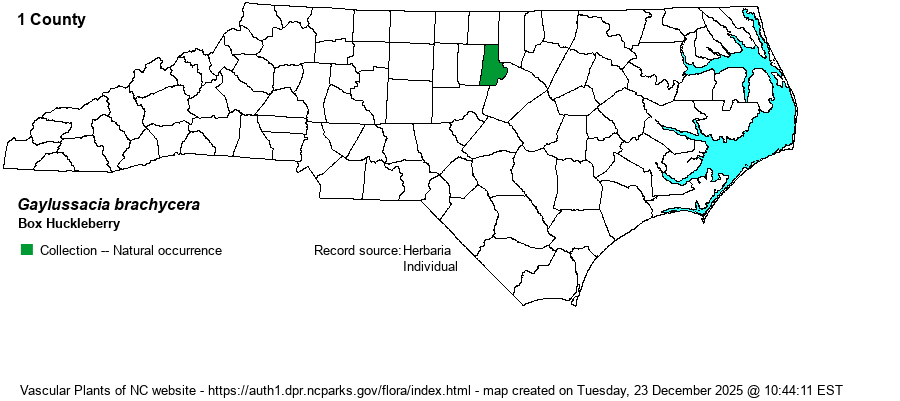| Author | (Michaux) A. Gray | |
| Distribution | This species has been reliably been documented only from Durham County, in the northeastern Piedmont. It was discovered in April 2003 by Bob and Ellen Wilbur and Stephan Bloodworth. As it has been found in southwestern VA, close to the NC boundary, it is to be looked for in the northwestern part of the state, especially in the foothills. There has been much discussion if this population, disjunct eastward by over 100 miles from other sites, is native or introduced. As the habitat is typical for the species, the site is in an undisturbed area, and locals there know of no evidence of it being planted, for now it is considered as a native population.
This species has a very small and narrow range, occurring only in a few dozen counties in the Appalachian Mountains and nearby areas – southern PA south to NC, and in the Cumberland Plateau of eastern KY and TN. It has also been found well away from the mountains in southern DE.
| |
| Abundance | Very rare, known from just a single NC site. However, it is abundant there, as the species is clonal; thousands of stems are present. It is a State Endangered species. | |
| Habitat | Across its range it occurs in dry and acidic forests, typically on ridges and upper slopes. The site in NC is similar – a dry ridge and upper slope, where it grows down a steep slope, at a heath bluff with Mountain Laurel (Kalmia latifolia). | |
| Phenology | Blooms in May and June, and it fruits generally in June. | |
| Identification | This is a low and clonal evergreen shrub, growing only to about 1-1.5 feet tall. It should be easily recognized by its growth in dense and extensive shin-high to knee-high stands and small shiny leaves that are wavy-edged (crenate), even if flowers or berries are not visible. The leaves are remarkably similar to those of Yaupon Holly (Ilex vomitoria), but that species grows mostly near the coast in flat and sandy soils and has a much taller growth form. However, that species does escape from time to time, so there is a small chance of confusion, though it is unlikely that Yaupon Holly would escape to a xeric and usually hilly forest. Also, the huckleberry has clusters of small, dangling, white to pinkish urn-like flowers followed by dark berries; the holly has flat, five-petaled white flowers in clusters followed by red berries. | |
| Taxonomic Comments | It looks so unlike our other huckleberries, which are all deciduous with thin leaves, that it deserves to be placed in another or in its own genus. Note that the ”Gaylussacia brachycera” as named in RAB (1968) is now considered to be the newly described Vaccinium sempervirens, found only in a small area of central SC. Former names for Box Huckleberry include Buxella brachycera and Vaccinium brachycerum.
| |
| Other Common Name(s) | Box-leaved Whortleberry (rarely used) | |
| State Rank | S1 | |
| Global Rank | G3 | |
| State Status | E | |
| US Status | | |
| USACE-agcp | | |
| USACE-emp | | |

